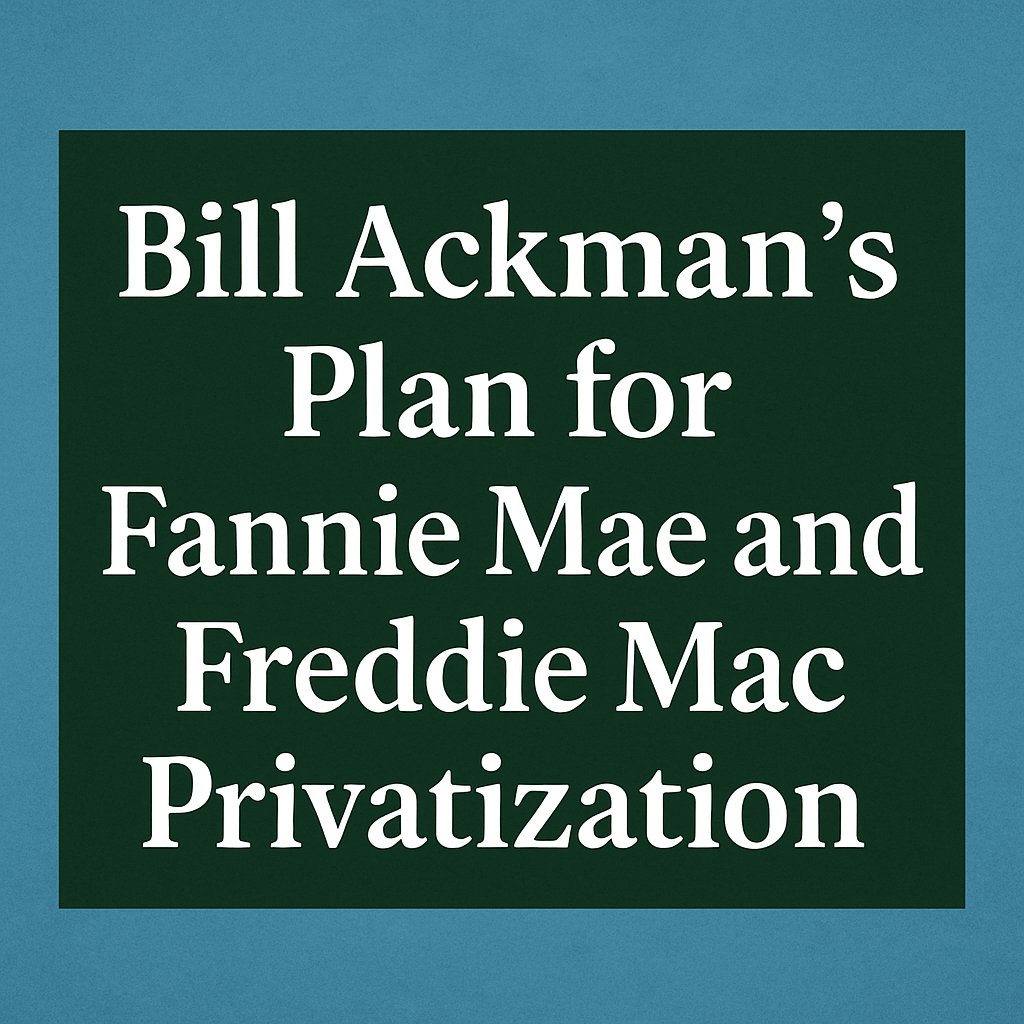Bill Ackman’s Plan for Fannie Mae and Freddie Mac Privatization

This week, President Donald Trump made a long-awaited announcement regarding the Federal National Mortgage Association (Fannie Mae) and the Federal Home Loan Mortgage Corporation (Freddie Mac). In a Truth Social post on Tuesday, Trump stated: “I am working on TAKING THESE AMAZING COMPANIES PUBLIC, but I want to be clear, the U.S. Government will keep its implicit GUARANTEES, and I will stay strong in my position on overseeing them as President.” While Trump’s proposal to privatize these government-sponsored enterprises (GSEs) highlights a significant intersection of politics and finance, it also underscores a multitude of potential challenges that must be navigated carefully.
Background and Current State of the GSEs
The GSEs have been under the conservatorship of the Federal Housing Finance Agency (FHFA) since September 2008, a critical juncture when their insolvency sent shockwaves through the global financial system. Today, Fannie Mae and Freddie Mac are pivotal players in the housing finance sector, carrying over $7 trillion in mortgage assets. These mortgages underwrite approximately half of all U.S. single-family home loans and roughly one-third of multifamily financing.
Despite growing profitability, the health of the GSEs remains tenuous. For instance, by the conclusion of 2024, Fannie Mae was operating at an alarming leverage ratio of 46-to-1, compared to Freddie Mac’s 57-to-1. This level of leveraging is far beyond the 20-to-1 cap typically observed within major banks, placing considerable strain on their operational stability.
Opportunities and Risks of Privatization
Moving towards privatization presents enormous opportunities but is accompanied by significant risks. The prospect of the largest public stock offering in U.S. history, potentially eclipsing the likes of General Motors and Alibaba, raises complex questions about market structure and investor confidence. Experts argue that incorrect privatization frameworks could put hundreds of billions of dollars at risk, potentially leaving taxpayers vulnerable to future financial crises.
Historically, Fannie Mae and Freddie Mac have benefitted from favorable financing conditions due to their implicit government backing, which allowed them to dominate mortgage markets during the late 20th and early 21st centuries. Their ability to provide low-cost mortgage options has often been touted as a significant achievement in making home ownership accessible to millions of Americans. Yet, the same structure has contributed to heightened risks and dubious practices when the GSEs engaged in risky lending with taxpayer protections shielded behind them.
Regulatory Considerations and Market Dynamics
Despite these concerns, there exists a distinct advantage to reconsidering the GSEs’ structure within a regulatory environment that expects prudential oversight and risk management. Bill Ackman, an investor and vocal advocate for the privatization of the GSEs, has outlined his vision, which emphasizes the need for Fannie Mae and Freddie Mac to remain outside bank regulatory frameworks while still ensuring they have access to capital markets.
Ackman’s plan suggests that a legitimate government backstop should be established, likened to a form of reinsurance that would eliminate ambiguity concerning taxpayer liabilities. However, the intricate details of this proposal raise questions about government intervention in the housing market and its corresponding impacts on financial stability and transparency.
Key Changes Needed for Effective Privatization
- Rechartering and Regulation: It is crucial for the GSEs to be rechartered as Financial Holding Companies and recognized as systemically important institutions. This reclassification would invoke oversight from the Federal Reserve, enforcing a requirement to maintain sufficient capital buffers and manage risks in line with best practices observed in the banking sector.
- Elimination of Funding Advantages: The GSEs must relinquish their favorable access to financing based on their federal affiliation. Future transactions involving agency debt and mortgage-backed securities (MBS) should align with private sector standards to ensure equitable treatment in the capital markets.
- Legislative Actions: To effectively sever ties with government-sponsored advantages, Congress must enact major legislation terminating the GSEs’ direct role in housing policy. A strategic separation from government intervention is necessary to ensure their competitiveness in the mortgage market.
Market Implications and Investor Perspectives
When considering the ramifications of privatization, investors are aware that privatized GSEs will likely be smaller than their pre-2008 counterparts. The privatization process demands a robust strategic framework that not only ensures adequate capitalization but also emphasizes corporate governance structure to instill investor confidence. Any plans to sell equity will necessitate meticulous execution over several years.
While Ackman envisions a fast-tracked executive course for privatization, it is essential to remember that a successful transition will rest on comprehensive preparation, sound regulatory compliance, and a clear delineation of responsibilities between the government and privatized entities.
Conclusion
The conversation surrounding the future of Fannie Mae and Freddie Mac continues to evolve amid a complex maze of financial and political considerations. As this dialogue unfolds, it becomes increasingly clear that privatization, if executed thoughtfully and transparently, holds the potential to strengthen the U.S. housing market without returning to the reckless lending practices that contributed to the 2008 financial crisis. As such, it is paramount that stakeholders focus on establishing a financial framework that prioritizes stability and prudent risk management in any implementation of privatization expeditions.
“There is no reason why the GSEs cannot compete alongside other mortgage-backed securities issuers as private entities. However, it would be reckless to privatize them while maintaining existing government advantages and subsidies.”
Source: fortune